How To Properly Install A Commercial Sound System


Holding a degree in Business Administration and Programming, Pablo established Legis Music in 2016. With a focus on the royalty-free music industry, he has contributed extensively to the field, authoring over 150 articles on various aspects of music licensing. His efforts have been instrumental in developing one of the most straightforward and liberal music licensing frameworks available today.
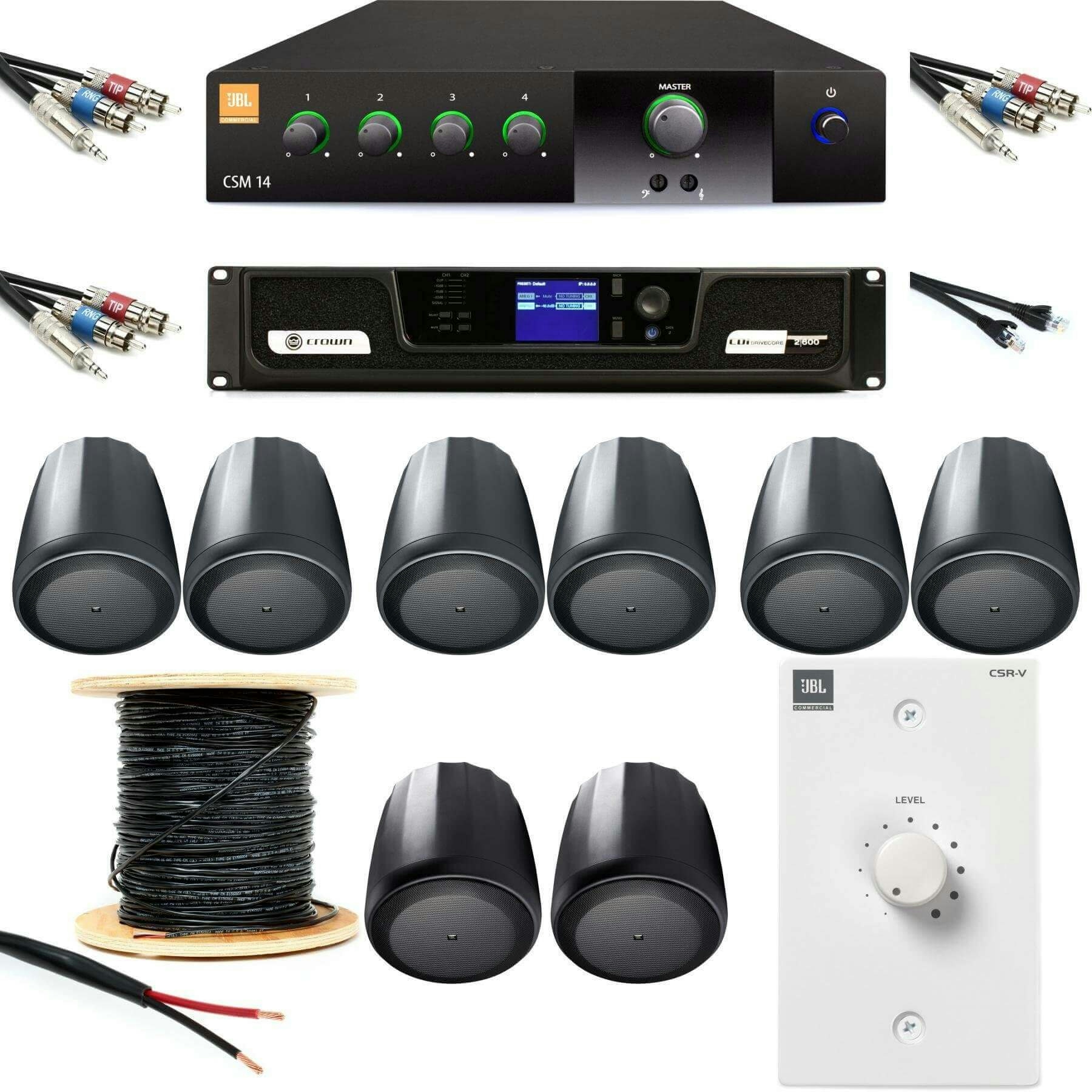
Key Takeaways
- Sound influences customers’ decisions and emotions, and is key to sensory marketing.
- Commercial sound system components include a licensed music provider, sound source, amplifier, mixer, cables and speakers.
- Appropriate music must be selected and licensed for commercial use.Installation considerations include: differentiating between home and commercial systems, considering acoustics, volume, type of music, and type and distribution of speakers.
- To set up the system, the specific needs of the business must be evaluated to determine the most appropriate sound system.
Although we often don’t pay attention or think we are in absolute silence, sound is something that accompanies us at all times from the moment we are born.
Right now, as you read these lines, you are also hearing something: it may be the noise of your environment or your breathing, but the reality is that your brain is constantly interacting with auditory information.
At least, this has been repeatedly demonstrated by numerous scientific investigations.
 Everything we hear has a huge influence on us, both internally and externally, and can change our perceptions, emotions, and decisions.
Everything we hear has a huge influence on us, both internally and externally, and can change our perceptions, emotions, and decisions.
And this is something that successful businesses know very well.
They know that sound is part of the so-called sensory marketing, and by stimulating their consumers with a quality sound they can increase their sales considerably.
According to a HUI Research study conducted in 2016, restaurants that played music aligned with their culture increased sales by more than 9% (*).
Now, while choosing the right music for your type of business is critical to your marketing strategy, this is not the only aspect to consider.
Auditory marketing experts know that to achieve the best results with music in a business, the music selection must be accompanied by a good sound system.
A high-quality listening experience reinforces the brand’s image and values, and these components have a direct influence on the customer’s purchasing decision.
Therefore, in the same way, that the design of an interior or the layout of the spaces of a business is carefully chosen, the best commercial sound system must be chosen.
 This task usually belongs to a sound designer or a professional audio installation service, which will make decisions such as the necessary sound power, the number of speakers, or their distribution.
This task usually belongs to a sound designer or a professional audio installation service, which will make decisions such as the necessary sound power, the number of speakers, or their distribution.
However, if you are on a tight budget and this option is not economically feasible, you may want to do this process on your own.
We know it may seem a bit complicated at first, but don’t worry, because we’ve created this article to make things easy for you.
We recommend you stay until the end so you will learn everything you need to know to choose and install the right commercial sound system for your business.
Components of a commercial sound system
Sound systems for commercial use usually have 6 fundamental elements, which are the following:
- Music provider (+ public performance music license)
- Sound source
- Amplifier
- Volume control or mixer
- Cables
- Speakers
We have placed them in this list in order so that you can more clearly see the audio signal path from beginning to end.
We will take a more in-depth look at each of them below.
Music suppliers and licenses
The main purpose of installing a commercial sound system is to establish a musical sound background in your business.
And to do so in compliance with the law, you must do so in one of the following ways:
- In the most complex and expensive way: acquire the copyright of each song that you are going to play in your business separately.
- The simplest and cheapest way: purchasing a music provider that allows you to legally reproduce the music your business needs.
We imagine that you don’t want to complicate your life unnecessarily, so hiring a good music provider is your best option.
However, you must make sure that the music provider is allowed to play music on a commercial level.
For example, you will not be able to use your personal Spotify account, your YouTube Premium subscription, or your downloaded songs from iTunes.
These platforms allow the use of music in a personal level environment and in private environment.
To play music in a public and commercial environment, you will need a specialized business music provider.
You can find many of them on the Internet, as we mentioned in our guide “ Music streaming services for business ”.
However, if we have to recommend just one, that would be Soundtrack Your Brand , which we consider the best.  This platform brings you one of the largest music libraries available for businesses, as well as intelligent software that will choose the perfect music for your business.
This platform brings you one of the largest music libraries available for businesses, as well as intelligent software that will choose the perfect music for your business.
With its monthly subscription Soundtrack Essential, which costs $34.99 per month -for the USA and Canada-, you will have at your fingertips:
- More than 51 million songs are licensed for retail stores
- More than 400 ready-made playlists
- Over 7000 possible artist stations
- Easy music programming via the ‘Drag&Drop’ system.
- Explicit lyrics filter
If you want to learn more about this service to find out if it is the music provider your business needs, you can take a look at our review.
We’ve called it “Spotify for Business” (you’ll know why once you read the article).
And before we move on to the next component, an important warning:
Both Soundtrack Your Brand and other music providers typically have commercial performance and playback licenses, but not commercial public performance licenses.
Therefore, to play music from such services legally, you will need to acquire such a license through the PROs or through the corresponding authors’ society in your local country.
Sound source
Another element of a commercial sound system is the sound source.
This refers to the actual device from which you will play the music.  Many businesses prefer to have a PC or laptop whose exclusive use is to play music.
Many businesses prefer to have a PC or laptop whose exclusive use is to play music.
Other businesses choose to handle the music aspect from a more portable device, such as a tablet or smartphone.
The sound source will depend largely on the music provider you choose.
In case you opt for Soundtrack Your Brand, one of its advantages to highlight is that it is a multiplatform service.
That is to say, you will be able to manage it from a computer, a laptop, as well as from your tablet or smartphone.
Amplifier
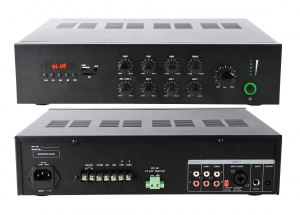 Once we have the music provider and we have chosen the device through which we will play it, the next thing to choose is the amplifier.
Once we have the music provider and we have chosen the device through which we will play it, the next thing to choose is the amplifier.
This device is responsible for receiving the electrical signal from the audio source, control the volume and tone of the signal and send it to the speakers.
The amplifier is a key element in commercial distributed sound systems, and therefore two fundamental things should be taken into account:
- That it is a reliable brand in the market, that is to say, we opt for an amplifier of great quality, robustness, and guarantee.
- That it has the necessary power to feed all the speakers that your sound system is going to have.
- That the output impedance of the amplifier matches the input impedance of the speakers to be connected or vice versa.
Impedance is the resistance to the passage of electric current and is measured in Ohms (Ω).
Volume control or Mixer
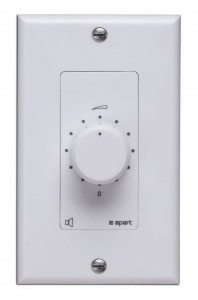 Previously we have just mentioned that the amplifier controls the volume and sends the signal to the speakers.
Previously we have just mentioned that the amplifier controls the volume and sends the signal to the speakers.
However, depending on how is the installation of the commercial sound system and the number of areas that are in your business, it may be advisable to use a mixer.
In the very likely case that you need it, it will be the one that receives the previously amplified signal, controls the volumes, and supplies each group of speakers separately.
Cables
The cables are the ones that allow the transmission of the signal from the source from which the sound comes out to the speakers.
If we choose to use wireless speakers, it is a questionable reputation quite possible that we do not need them, or perhaps we need fewer cables.
However, most traditional commercial sound systems use cables, and therefore it is necessary to include them in the components we need. These cables can be differentiated in several ways.
One of them is according to their way of transmitting the signal, among which we can find analog cables (transmit electrical signals) or digital cables (transmit binary code, that is, zeros and ones -the language of computers-).
If we use cables in our commercial sound system, with a high probability, we will use analog cables.
These in turn can be differentiated between unbalanced (susceptible to receiving external noise interference) and balanced (designed to cancel any interference).
Having clarified the above classifications, cables for a commercial sound system are usually of the following types.
RCA
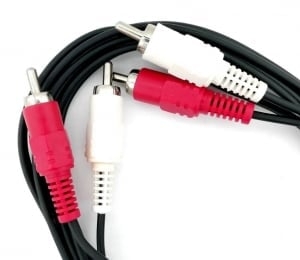 This is an unbalanced stereo cable, easily identifiable by having a red connector -for the right sound- and a white one -for the left sound.
This is an unbalanced stereo cable, easily identifiable by having a red connector -for the right sound- and a white one -for the left sound.
They are usually widely used in deejay sound systems, where both the CDJs or turntables and the speakers must be connected to the mixing desk.
TS / TSR
You may not be familiar with this terminology, but they are also known as jack connectors. 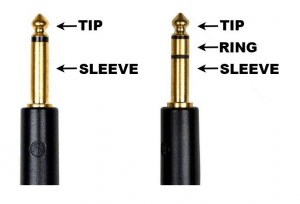
Depending on the size of the jack, it can be a mini-jack (the classic type of connector for headphones) or ¼ jack (so-called because they are a quarter of an inch and are somewhat thicker than the mini-jack).
Both can be TS (Tip-Sleeve) or TPS (Tip-Ring-Sleeve) depending on whether they have 2 or 3 wires inside.
- TS has two wires: a conductor and a ground. This makes them mono (single channel) and unbalanced connectors.
- TSR cables have 3 wires: two conductors and a ground. This allows them to be balanced when used as a mono cable (one inner conductor will carry the signal and the other will cancel the noise) or unbalanced when used as a stereo cable (one conductor carries the signal of the right channel and the other conductor carries the signal of the left channel).
XLR
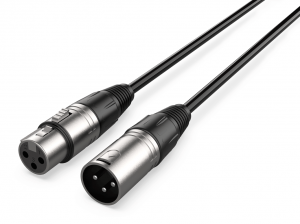 This type of cable is the most commonly used in commercial sound systems for concerts and live performances.
This type of cable is the most commonly used in commercial sound systems for concerts and live performances.
They are widely used professionally for several reasons:
- You can connect a wide range of electronic and musical devices, such as powered speakers, microphones, instruments, or PA systems (sound reinforcement).
- They are balanced, so you can be sure that no signal will interfere with the final sound quality.
- They are very thick cables, resistant to external agents (dust, water, etc.), and can be very long.
- If you need long cables, you can connect several XLR cables or ask a manufacturer to make a custom cable with the length you need.
- Its connector is click type, something that keeps the equipment connected even if cable pulls arise.
Speakers
And as the last item in this list of necessary components in a commercial audio system is the speakers, which are perhaps the most important components of the sound system.
They are the last link in the chain, and ultimately, those that will provide the sound quality.
Depending on their connectivity, they can be wired or wireless.
We will find out later which of the two is advisable to use, but now we will focus on the different types of speakers depending on their arrangement.
Ceiling speakers
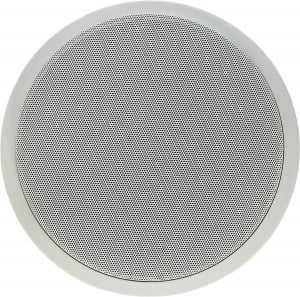 This is a type of speaker that is placed between a false ceiling and the load-bearing ceiling.
This is a type of speaker that is placed between a false ceiling and the load-bearing ceiling.
It gives a very elegant aesthetic touch and is ideal for businesses whose premises have sloping ceilings.
Pendant speakers
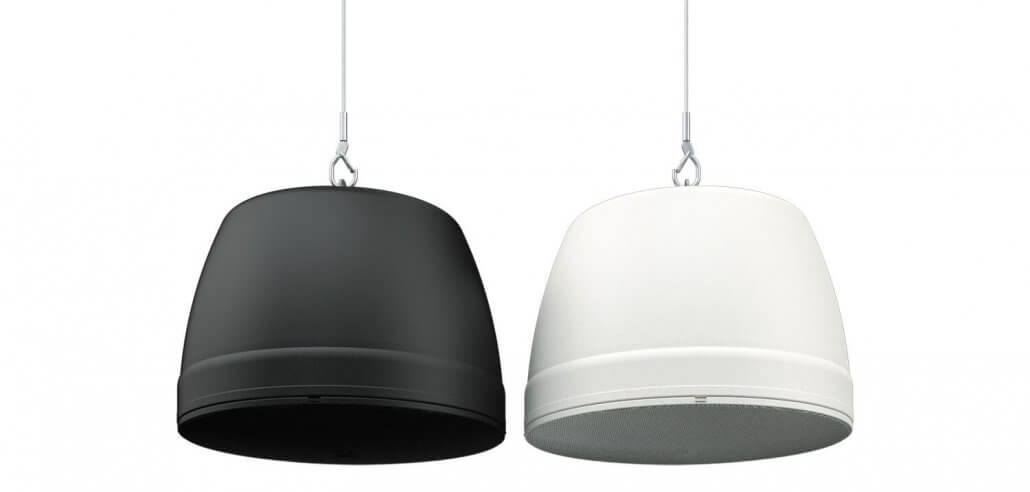 These are speakers that, as the word itself says, hang from the ceiling through a usually long cable.
These are speakers that, as the word itself says, hang from the ceiling through a usually long cable.
If you are not considering the option of installing a false ceiling, but you have a high commercial space, hanging speakers will be a very original alternative.
Surface mount speakers
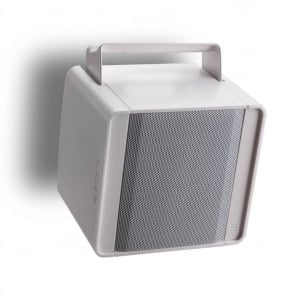 This is a type of loudspeaker that comes with a set of brackets so that it can be mounted almost anywhere on the premises.
This is a type of loudspeaker that comes with a set of brackets so that it can be mounted almost anywhere on the premises.
They are very common in clothing stores, hairdressers, and gyms, and although they are not as decorative as the two previous models, their ease of installation makes them one of the most popular options.
Horn speakers
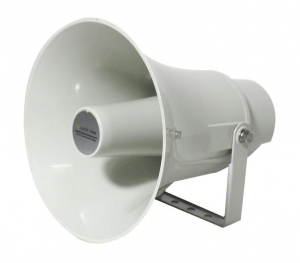 They are a very common type of loudspeaker in businesses and venues where voices and announcements must be heard clearly and crisply.
They are a very common type of loudspeaker in businesses and venues where voices and announcements must be heard clearly and crisply.
Due to their inability to reproduce high and low frequencies, horn loudspeakers concentrate their power in the mid frequencies associated with the human vocal range.
At the same time, its weather resistance makes it ideal for use in outdoor businesses such as stadiums or swimming pools.
Commercial sound system installation and configuration
At this point, you already know all the elements you will need to design your commercial sound system.
Later you will see things you will need to consider, as well as some tips for choosing and installing the equipment correctly.
However, now it is time to delve a little deeper into the installation of the same.
And for this, it is important to know the difference between how to connect a home stereo and a commercial one.
Home sound system vs. commercial audio system
In terms of components, there won’t be much difference between the two devices. 
Any basic sound system, whether commercial or home, will start with a music player, such as a smartphone, laptop, or radio.
However, the sound system configuration will differ between the two.
Home systems have multiple inputs or multiple amplifiers, with multiple speakers connected to each amplifier.
In addition, the impedance of each speaker must match the output impedance of the amplifiers to which they are connected.
And this way of doing it might be valid for small businesses.
However, the connection of a commercial sound system is usually such that the speakers are connected in line.
That is, from the output of a speaker to the input of the next one, and from the output of this one to the input of the next one, as we can see in the following image. 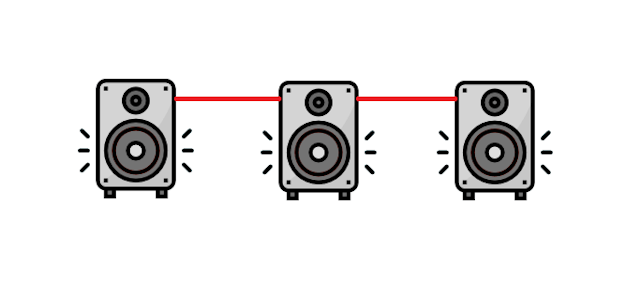 This is what is known as constant current systems or constant voltage systems, and the most common are 70-volt systems.
This is what is known as constant current systems or constant voltage systems, and the most common are 70-volt systems.
Understanding a 70-volt constant current system
Because the voltage is high, the current flowing through a 70-volt system is low.
One of the advantages of this type of connection is that 70-volt amplifiers can drive as many loudspeakers as they want, regardless of their impedance.
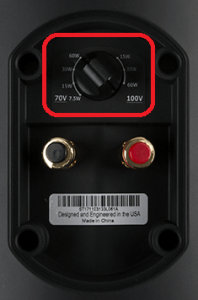 Each speaker incorporates a transformer that reduces the high voltage to a limited level that the speaker can withstand.
Each speaker incorporates a transformer that reduces the high voltage to a limited level that the speaker can withstand.
The transformer has several taps to achieve different power levels for the speaker.
The higher the power tap, the louder the speaker will sound.
Therefore, it does not matter how many loudspeakers are connected to a 70-volt commercial sound system, as long as the total power of the sum of the speakers does not exceed the capacity of the amplifier.
Professional audio system designers often choose amplifiers with more power than the total rated power of all their speakers.
In addition, they also typically reserve 10% to 20% of an amplifier’s power as additional headroom for those occasional times of peak demand.
This means that a single 500-watt amplifier could easily drive 80 to 90 5-watt speakers, for example.
With that understood, let’s take a look at what a commercial audio system installation would look like.
Installing the commercial sound system
Before installing a sound system in your business you should know several aspects to consider, which we will see later.
But now, let’s see a small sketch of the installation and how the signal travels from the beginning to the end. 
Once the music provider and the corresponding license to play music legally have been acquired, we must choose the sound source from which we will play the sound. As previously mentioned, it is usually a smartphone, a tablet, a laptop, or a desktop computer. From the sound output of any of these devices, a cable should be used to the audio input of the amplifier.
Normally, it is usually a mini-jack (TS/TSR) cable, whose connector is similar to a headphone jack. Now we will connect one of the outputs of our amplifier to the input of the volume mixer, and we will do this with one type of cable or another depending on the inputs and outputs of each device.
The most professional would be to use XLR cable, although it can also be done with TS/TSR or RCA. Subsequently, we connect the output of the mixer to the input of the first speaker in the chain, and the output of this to the input of the next speaker.
We can continue connecting speakers in this way indefinitely, as long as the power rating of the speakers does not exceed that of the amplifier.
What to consider when setting up your commercial sound system
At this point, you already know all the elements you will need to design your commercial sound system, as well as a general idea of how it will be installed.
But there are still many questions to be answered.
So we will dedicate this section of the article to discover all those things you should consider before buying the material and installing it.
Acoustic conditioning
When it comes to playing music in a certain space, it is important to know the acoustic properties of the different elements against which the sound waves will impact.
For example, music will not sound the same in a space with a carpeted floor, a concrete floor, or a wooden floor.
Each of these and other materials offers a different sound depending on their:
- Porosity
- Stiffness
- Density
Ideally, the porosity should be zero – or as low as possible – so that it does not absorb sound waves.
As for stiffness, the lower the stiffness, the greater the sound reduction. And regarding the density of the material, the higher the value, the more insulation it will provide with respect to other areas of the building, or it’s exterior.
Ceiling height
You probably know that in enclosed spaces with high ceilings there is a reverberation effect.
This effect together with an average volume of music and the usual noise of a business open to the public can create an uncomfortable background sound that can be detrimental to the customer’s experience.
There are techniques to reduce the height of the premises, with false ceilings that can help create an ideal acoustic environment in addition to reducing reverberation.
Music volume
Controlling the volume of the music is critical to delivering an exquisite customer experience. 
However, the right volume will depend directly on the type of business you have, as well as the clientele that comes to it.
For example, the volume used in a clothing store will not be the same as that used in a gym or a gourmet restaurant.
Type of music
The same as we have mentioned about the volume of the music we can say about the type of music.
Classical music may not be the most appropriate in the fitness room of a gym, but it would be the most appropriate in a hotel lounge.
Just as electronic music might not be the best for a supermarket, but it would be the best for a youth clothing store.
Type of speakers
Previously you saw the different types of speakers that are commonly used in businesses, and you also saw that not all of them are suitable for every type of establishment.
Chances are you won’t need to use horn speakers in a tapas bar, but you will use them in a theater or a racetrack.
The same can be said for wireless or wired speakers. 
We probably will not use wireless speakers in an open space where signal loss is highly likely, but they may be recommended in enclosed spaces that are smaller.
Number of speakers
There has been a tendency to think that to improve the sound quality in a business you should add few speakers of higher power but placed in the right places.
Similarly, there have also been currents that thought the opposite: that the most appropriate was to place many speakers of lower power to cover each space of the business.
The truth is that both ways can be correct depending on the type of business and the type of premises.
7 tips for professionally configuring your company’s sound system
Now that you have seen the most important things to consider before buying your sound system components, we are going to provide you with a series of recommendations to make your setup much easier.
1. Evaluate your needs and those of your business very well
When we talk about the needs of the business we are referring especially to the type of music to be played as well as the volume it will have.
It is necessary to decide beforehand if the music is going to have a low volume to be listened to in the background, or if it is going to be louder.
This will depend, for example, on the size of the speakers to be used.
If you need energetic music with a considerable volume, the speakers will need to be somewhat larger to give a better bass response.
On the other hand, if you opt for small speakers whose bass response is not as good, they may be acceptable for playing music at low volume, but will offer an unnatural sound when the volume is turned up a little.
That is why it is always recommended to have speakers whose performance is slightly higher for the use required by your business.
2. Purchase a quality sound system for the long term
 A good commercial sound system is one that, in addition to meeting the sound requirements of the business, has been made in such a way to have great durability, being able to operate at full capacity for 10, 20, or even more.
A good commercial sound system is one that, in addition to meeting the sound requirements of the business, has been made in such a way to have great durability, being able to operate at full capacity for 10, 20, or even more.
To achieve this, it is advisable to stay away from low-cost products with a questionable reputation, which may save you a few dollars now, but may give you problems in the near future.
In this case, we suggest paying a little more money in exchange for peace of mind, reliability, and durability, relying on brands with years of reputation in the market, such as:
- Yamaha Pro
- JBL Commercial
- Bose Professional
- Pioneer
- Bowers & Wilkins
- Bang & Olufsen
- Sennheiser
- Sony
- Sonos (inalámbricos)
Here we will not only value the quality of each of the components of our commercial sound system, but we must also value the after-sales service, periodic maintenance service, the possibility of quick replacement in case of any mishap with the equipment, or the ease of updating. equipment.
Although at first, it may seem otherwise, by choosing good brands and good components, you will be buying equipment that will be more expensive provides but will be much more profitable in the long run.
3. If possible, place the loudspeakers on the ceiling
Many professionals in the sector have the habit of considering sound as if it were light.
And following this way of treating sound, in the same way, that we would not place a spotlight on the side of a store, or in a corner of the room, we should not do the same with loudspeakers.
If we project light from the side, the light rays will enter directly into our eyes, making it difficult for us to see our surroundings.
Therefore, what we want is that it spreads evenly, from top to bottom.
Using the same premise with sound will allow its correct propagation throughout all the spaces of the business, creating an enveloping sensation of continuity, without dead zones lacking sound, something that will translate into a great sensory experience.
4. More quantity of small speakers instead of fewer powerful speakers
 Related to the previous point, if we treat sound like light itself, speakers should be treated like spotlights.
Related to the previous point, if we treat sound like light itself, speakers should be treated like spotlights.
Using a few large spotlights will create lighting with too much light in certain areas and some gloom in others.
Similarly, using too few large speakers will create nonuniform sound, with sound overload in some areas and a lack of sound in others.
To avoid this problem and improve the sound experience of customers, it is best to add more speakers but of a smaller size.
If you plan to play high-fidelity music in your business, 6″ or 8″ models could be a good option.
However, if you only want to play soft background music, 4″ speakers might be the best choice.
However, don’t forget tip number 1: buy speakers slightly above your requirements so you don’t run out of sound.
5. Properly space and combine different types of speakers
You have already seen that to achieve correct musical coverage in any space of the business it is necessary to take into account several factors, among which is the height of the premises.
If ceiling speakers are chosen, we must know how far away they should be placed from each other, since:
- If the speakers are spaced too far apart, the sound tends to be dispersed.
- But if they are too close together, overloaded sound zones can be created.
In ceilings lower than 3 meters, a smaller distance between speakers will be required, since the high and mid frequencies will not be lost and there will be fewer dead zones.
This will allow us to choose speakers with a larger diameter and, therefore, better bass response.
On the other hand, in ceilings higher than 3 meters, the distance between speakers may be greater.
And as there is more distance from the floor, there are greater losses in treble and midrange, so we will have to opt for smaller diameter speakers or speakers with the tweeter to reinforce these lost frequencies.
A good commercial sound system is one that provides a significant overlap between the coverage of the speakers so that the listener always hears the sound from more than one speaker.
And to do this correctly there is a widespread rule of thumb:
The distance between speakers should be twice the height of the ceiling.
In general, the rule of thumb is to take the ceiling height (in feet), subtract five and multiply by two. For example, your business has 15-foot ceilings, 15 minus 5 is 10, 10 multiplied by 2 is 20. Each of your speakers should be about 20 feet away.
Using this rule and a correct choice of speakers, you will guarantee your customers great sound quality and its correct diffusion in your establishment.
6. Wired speakers ahead of wireless
Wireless speakers are a type of speaker that has become very fashionable in recent years.
And understandably so, as it offers greater flexibility of connection between devices without sacrificing high sound quality.
However, its connection via WiFi or Bluetooth is not without risk.
No matter how reliable the components, wireless connectivity is susceptible to interference and connection loss.
Just as we can lose the wifi signal on our smartphones if we move away from the router, the same can happen with wireless speakers, especially in a place with a considerable influx of people.
And that loss of signal can result in music cuts or even a potential drop in connection, something that would have a terrible impact on the customer experience.
It is true that these types of systems are becoming more and more sophisticated and less susceptible to this type of problem.
But if you want to have absolute peace of mind regarding sound transmission and avoid these potential interferences, it is best to opt for wired speakers.
After all, they have worked excellently and reliably for decades and continue to do so today.
7. If you don’t want to worry, trust professionals
 Many of the things you’ve learned in this article will help you get a general idea of a commercial sound system setup, as well as what components are needed or why some recommendations are made.
Many of the things you’ve learned in this article will help you get a general idea of a commercial sound system setup, as well as what components are needed or why some recommendations are made.
However, putting all of this into practice is a quite cumbersome task.
And in the same way that a waiter is not going to manage a restaurant, or the restaurant manager will not directly serve his customers, perhaps it is not the most recommendable that you carry out the purchase and installation of the sound system of your business by yourself.
If you want to take the sound of your business to a professional level, it is usually common and appropriate to delegate this task to professionals or companies that have been performing this task for many years.
This way you ensure that everything will be installed in the best possible way, and you can spend your time on the tasks you do best, such as improving and scaling your business.
Conclusion
Having a professional sound system is essential for you, your business, and your customers.
You already know that music is one of the pillars of sensory marketing and that playing it clearly will directly influence the experience of your users, and therefore, your sales.
That is why it is essential to get a sound system of the highest quality, betting on brands with a great reputation and proven experience.
However, it is just as important to acquire great equipment as it is to install it correctly.
Otherwise, not only will not take advantage of all the sound quality of your equipment, but it can also overload certain areas with sound or mute others, creating a negative impact on the experience of your customers. 
Luckily now you know everything you need to know to install it correctly: each of the components you need and their requirements, the key points you should take into account, and even 7 tips that will help you set up your commercial sound system.
From LegisMusic we encourage you to put all this into practice so you can give your customers the best possible sound experience.
References
- Considerations when carrying out sound system installations . Peridon
- What is a sound installation? MusicalExpert
- 5 tips to set up your business sound system like a pro. Soundtrack Your Brand
Why you can trust Legis Music
-
We offer comprehensive and expertly information about music licensing since 2016.
-
The website regularly updates its content to reflect the latest changes in music law, ensuring accurate information.
-
Our dedication to clarity and accuracy in explaining music rights and licensing issues builds trust among musicians, producers, and clients.
Get a Lifetime Music License
Never worry again about copyrights or claims. Unlimited downloads and social media channels. Use the music wherever you want!
Get a License

